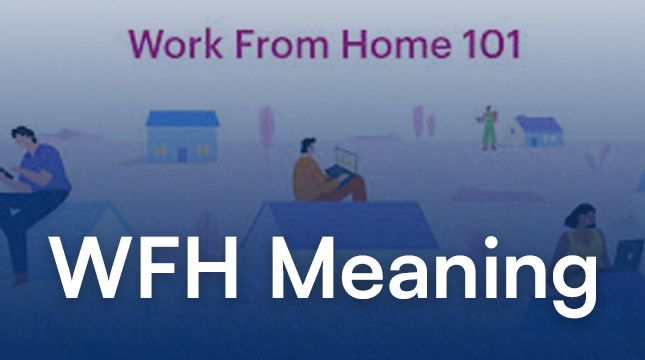This website uses cookies so that we can provide you with the best user experience possible. Cookie information is stored in your browser and performs functions such as recognising you when you return to our website and helping our team to understand which sections of the website you find most interesting and useful.
WFH meaning: When Every Day is Casual Friday

The acronym WFH, which stands for “work from home,” has become a ubiquitous part of our professional vocabulary. The COVID-19 pandemic accelerated the adoption of WFH arrangements, and many companies are now offering flexible or fully remote work options. But what exactly does WFH entail, and what are some of the upsides and downsides to consider?
What is WFH?
Work From Home (WFH) is a flexible working arrangement where employees can perform their job duties from their own homes instead of commuting to a traditional office setting. This practice leverages technology such as the internet, laptops, smartphones, and various collaboration tools to maintain productivity and communication with colleagues and clients.
The Rise of WFH
The widespread adoption of WFH can be attributed to several factors, with the COVID-19 pandemic serving as a significant catalyst. When offices around the world were forced to close, businesses quickly adapted to remote work to continue operations. This period demonstrated that many jobs could be performed effectively outside the traditional office environment.
Benefits of WFH
- Flexibility and Work-Life Balance: One of the most celebrated advantages of WFH is the flexibility it offers. Employees can tailor their work schedules around personal commitments, leading to better work-life balance.
- Increased Productivity: Contrary to initial concerns, many studies have shown that remote workers can be more productive than their office-bound counterparts. The absence of a daily commute, fewer office distractions, and the ability to create a personalized work environment contribute to enhanced productivity.
- Cost Savings: Both employers and employees can benefit financially from WFH. Employers save on office space and utilities, while employees save on commuting costs, work attire, and meals.
- Environmental Impact: Reduced commuting leads to fewer carbon emissions, contributing to environmental sustainability. The shift to WFH has shown a positive impact on reducing the carbon footprint associated with daily commutes.
Challenges of WFH
While WFH has numerous advantages, it also presents several challenges:
- Isolation and Loneliness: The lack of social interaction can lead to feelings of isolation and loneliness among remote workers. Maintaining team cohesion and morale can be challenging without regular face-to-face interaction.
- Work-Life Boundaries: The line between work and personal life can blur, leading to overwork and burnout. Establishing clear boundaries and maintaining a structured routine is crucial to preventing this.
- Technical Issues: Reliable internet connectivity and access to appropriate technology are essential for effective remote work. Technical issues can hinder productivity and cause frustration.
- Communication Barriers: Remote work relies heavily on digital communication tools. Miscommunications and misunderstandings can occur more easily without the nuances of in-person interaction.
Best Practices for Successful WFH
To make the most of WFH, both employers and employees should consider these best practices:
- Set Up a Dedicated Workspace: Creating a designated workspace helps establish a physical boundary between work and home life, enhancing focus and productivity.
- Maintain Regular Hours: Sticking to a consistent work schedule helps manage time effectively and prevents overworking.
- Use Technology Wisely: Leverage collaboration tools like Slack, Zoom, and project management software to stay connected and organized.
- Prioritize Communication: Regular check-ins and virtual meetings help maintain team cohesion and ensure everyone is on the same page.
- Take Breaks: Regular breaks are essential to avoid burnout. Incorporate short breaks and physical activity into the workday.
- Foster Social Interaction: Encourage virtual social interactions to combat loneliness and strengthen team bonds.
Is WFH Right for You?
Whether WFH is a good fit depends on your work style and preferences. Some people thrive in the autonomy and flexibility it offers, while others miss the camaraderie and structure of a traditional office setting. If you’re considering a WFH arrangement, talk to your employer about their policies and expectations.
The Future of Work
WFH is likely here to stay, and it will continue to reshape the way we work. As technology evolves and companies adapt, WFH arrangements will become even more sophisticated and widespread.

Let's Start Your Project
Get free consultation for your digital product idea to turn it into reality!
Get Started






